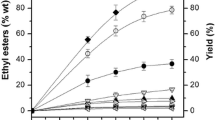Abstract
During the biotransformation of castor oil into γ-decalactone, R. aurantiaca produced both the lactone form and its precursor (4-hydroxydecanoic acid). After six days of culture, a maximum yield of γ-decalactone of 6.5 g/l was obtained. The parameters of γ-decalactone adsorption on three Macronet resins (MN-202, MN-102 and MN-100) were investigated in water. Adsorption isotherms of γ-decalactone for the three Macronet resins were linear. The trapping of γ-decalactone produced by R. aurantiaca on these resins was then carried out. γ-Decalactone was effectively retained by all the studied Macronet resins. The resin MN-202 trapped γ-decalactone more efficiently than MN-102 and MN-100. The percentages of γ-decalactone adsorbed on the resins MN-202, MN-102 and MN-100 were, respectively, 85, 75 and 81%, whereas around 70% of the adsorbed γ-decalactone was then desorbed. We propose an industrial process that uses Macronet resins to extract γ-decalactone from culture broth of R. aurantiaca.





Similar content being viewed by others
References
Serra S, Fuganti C, Brenna E (2005) Biocatalytic preparation of natural flavours and fragrances. Trends Biotechnol 23:193–198
Schrader J, Etschmann MMW, Sell D, Hilmer JM, Rabenhorst J (2004) Applied biocatalysis for the synthesis of natural flavour compounds-current industrial processes and future prospects. Biotechnol Lett 26:463–472
Aguedo M, Ly MH, Belo I, Teixeira JA, Belin JM, Waché Y (2004) The use of enzymes and microorganisms for the production of aroma compounds from lipids. Food Technol Biotechnol 42:327–336
Rabenhorst J, Gatfield I (2000) Method of producing γ-decalactone. Patent WO 0024920
Suryadi I, Suresh B (2000) Adsorption of flavour esters on granular activated carbon. Can J Chem Eng 78:892–901
Edris AE, Girgis BS, Fadel HHM (2003) Recovery of volatile aroma components from aqueous waste streams using an activated carbon column. Food Chem 82:195–202
Medeiros ABP, Pandey A, Vandenberghe LPS, Pastore GM, Soccol CR (2006) Production and recovery of aroma compounds produced by solid-state fermentation using different adsorbents. Food Technol Biotechnol 44:47–51
Souchon I, Spinnler HE, Dufossé L, Voilley A (1998) Trapping of γ-decalactone by adsorption on hydrophobic sorbents: application to the bioconversion of methyl ricinoleate by the yeast Sporidiobolus salmonicolor. Biotechnol Tech 12:109–113
Dufossé L, Souchon I, Feron G, Latrasse A, Spinnler HE (1999) In situ detoxification of the fermentation medium during γ-decalactone production with the yeast Sporidiobolus salmonicolor. Biotechnol Progr 15:135–139
Alchihab M, Destain J, Aguedo M, Majad L, Ghalfi H, Wathelet JP, Thonart P (2009) Production of γ-decalactone by a psychrophilic and a mesophilic strain of the yeast Rhodotorula aurantiaca. Appl Biochem Biotechnol 158:41–50
Davankov VA, Rogozhin SV, Tsyurupa MP (1969) URSS Patent 299165. In: Tsyurupa MP, Maslova LA, Andreeva AI, Mrachkovskaya TA, Davankov VA (1995) Sorption of organic compounds from aqueous media by hypercrosslinked polystyrene sorbents ‘Styrosorb’. React Polym 25:69–78
Krings U, Kelch M, Berger RG (1993) Adsorbents for the recovery of aroma compounds in fermentation processes. J Chem Technol Biotechnol 58:293–299
Gehrke M, Krings U, Berger RG (2000) Selective recovery of volatile flavour compounds using reversed-phase polystyrene adsorbents. Flavour Fragr J 15:108–114
Valderrama C, Cortina JL, Farran A, Gamisans X, Lao C (2007) Kinetics of sorption of polyaromatic hydrocarbons onto granular activated carbon and Macronet hyper-cross-linked polymers (MN-200). J Colloid Interf Sci 310:35–46
Rabenhorst J, Gatfield I (2002) Method of producing γ-decalactone using Yarrowia lipolytica strain HR 145 (DSM 12397). US Patent 6451565 B1
Matsukura M, Takahashi K, Ishiguro S, Matsushita H (1984) Adsorption of volatiles from roasted tobacco on activated carbon and desorptive recovery by ether extraction. Agric Biol Chem 48:971–975
Dufossé L, Feron G, Mauvais G, Bonnarme P, Durand A, Spinnler HE (1998) Production of γ-decalactone and 4-hydroxydecanoic acid in the genus Sporidiobolus. J Ferment Bioeng 86:169–173
Féron G, Dufossé L, Pierard E, Bonnarme P, Le-Quere JL, Spinnler HE (1996) Production, identification, and toxicity of γ-decalactone and 4-hydroxydecanoic acid from Sporidiobolus spp. Appl Environ Microbiol 62:2826–2831
Souchon I, Rojas JA, Voilley A, Grevillot G (1996) Trapping of aromatic compounds by adsorption on hydrophobic sorbents. Sep Sci Technol 31:2473–2491
Acknowledgments
We thank the government of Syria for their financial support of this study.
Author information
Authors and Affiliations
Corresponding author
Rights and permissions
About this article
Cite this article
Alchihab, M., Aldric, JM., Aguedo, M. et al. The use of Macronet resins to recover γ-decalactone produced by Rhodotorula aurantiaca from the culture broth. J Ind Microbiol Biotechnol 37, 167–172 (2010). https://doi.org/10.1007/s10295-009-0659-z
Received:
Accepted:
Published:
Issue Date:
DOI: https://doi.org/10.1007/s10295-009-0659-z




